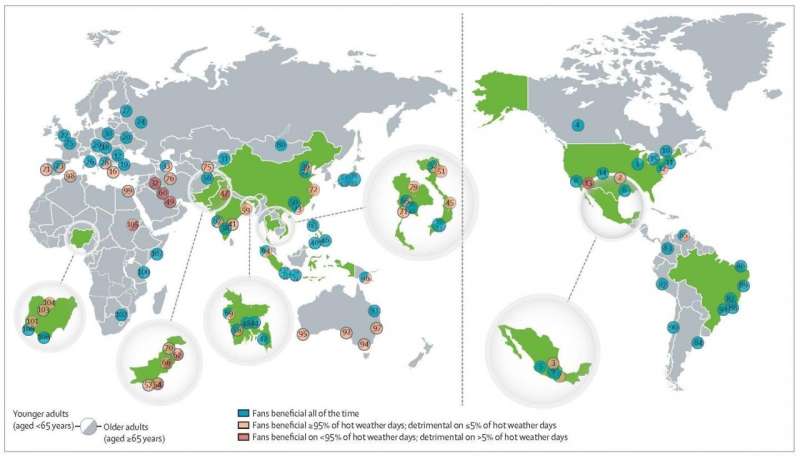
The biophysical modeling study, published in The Lancet Planetary Health, challenges outdated public health guidance that discourages fan use in temperatures higher than 35 degrees Celsius / 95 degrees Fahrenheit.
Based on human studies carried out at the University of Sydney’s Thermal Ergonomics Laboratory, the researchers developed a model to determine the humidity-dependent temperature thresholds at which fans could become detrimental, providing conditions that exacerbate heat stress.
“The effectiveness of a fan depends on temperature and relative humidity and our previous human studies have shown that it is only when the air temperature is very high and humidity is extremely low that fans can be detrimental,” said senior author Professor Ollie Jay, Professor of Heat and Health at the University of Sydney’s Faculty of Medicine and Health and Charles Perkins Centre.
“In this study we were able to model the impact of different conditions based on historic weather data. We have shown that for younger adults fan use could be recommended most of the time in most regions around the world, except for those living in extremely hot and arid areas.
“This is extremely important as air conditioning, both directly and indirectly contributes to greenhouse gas emissions. Electric fans on the other hand require 30 to 50 times less energy to operate. They are more sustainable and more accessible particularly in low- and middle-income countries.”
Key findings
Based on weather data from January 1, 2007 to December 31, 2019 the researchers found that contrary to many public health recommendations—including from the World Health Organization (WHO)—electric fan use for effective cooling without air conditioning could have been universally recommended for young healthy people during peak heatwave conditions in all populous cities in Bangladesh, China, Japan, Philippines, Indonesia, Canada, eastern regions of the USA, all of South America and Oceania and most of Europe (excluding some Mediterranean cities).
Fan use alone should not have been routinely recommended during hot weather in northern India, Pakistan, the Middle East, and the southwestern regions of the USA, because it would have regularly worsened heat stress.
The researchers note that alternative cooling strategies may be required in some regions for healthy older adult and particularly those taking anticholinergic medications (a class of drugs that block the Acetylcholine, a neurotransmitter) that impair sweating, the primary way in which our bodies cool down.
The authors conclude by demonstrating that worldwide guidance for electric fan use during heatwaves should be modified.
Specifically, they propose that the simplified fan use temperature threshold of 35°C currently recommended by the WHO should be increased to 39°C for young healthy adults, 38°C for healthy adults older than 65 years, and 37°C for older adults taking anticholinergic medication.
Lead author Dr. Nathan Morris, a post-doctoral researcher in environmental physiology at the University of Copenhagen, Denmark said: “Our hope is that public health authorities will modify their current heatwave recommendations to align with the latest scientific evidence. Broadening the use of these devices during heatwave conditions has the potential to both drastically reduce peak power demands and offer a low-resource alternative for those who do not have access to air conditioning.”
University of Sydney

